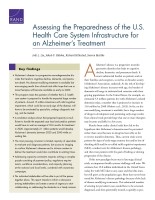| 来源类型 | Research Reports
|
| 规范类型 | 报告
|
| DOI | https://doi.org/10.7249/RR2272
|
| 来源ID | RR-2272-BIOG
|
| Assessing the Preparedness of the U.S. Health Care System Infrastructure for an Alzheimer's Treatment |
| Jodi L. Liu; Jakub P. Hlavka; Richard Hillestad; Soeren Mattke
|
| 发表日期 | 2017
|
| 出版年 | 2017
|
| 页码 | 16
|
| 语种 | 英语
|
| 结论 |
Addressing Alzheimer's Disease in Patients- Alzheimer's disease is a progressive neurodegenerative disorder that leads to cognitive decline, dementia, and premature death. No disease-modifying treatment is available today but encouraging results from clinical trials offer hope that one or more therapies will become available as early as 2020.
- This prospect raises the question of how well the U.S. health care system is prepared to handle the expected large number of patients. Almost 15 million people with Mild Cognitive Impairment, a condition that may signal early-stage Alzheimer's disease, are projected to live in the U.S. by 2019. They will have to be evaluated by specialists, undergo diagnostic testing for the disease and be treated.
Modeling a Future Caseload- A simulation analysis shows that projected capacity is insufficient to handle the expected case load and predicts that patients would have to wait an average of 18.6 months for treatment in 2020. Approximately 2.1 million patients would develop Alzheimer's dementia between 2020 and 2040 while on waiting lists.
- The most pressing constraint is limited capacity of dementia specialists to evaluate and diagnose patients, but access to imaging to confirm Alzheimer's disease and to infusion centers to deliver the treatment would also contribute to waiting times.
- Addressing the capacity constraints may turn out to be as challenging as developing an effective treatment, as it requires solving a complex puzzle consisting of payment policy, regulatory requirements, workforce considerations, and capacity planning at the national and local levels, combined with awareness campaigns.
- No individual stakeholder will be able to put all the pieces together alone. This report intends to inform a discussion among stakeholders and create a sense of urgency to start collaborating on addressing the obstacles in a timely manner.
|
| 摘要 |
- Our analysis suggests that wait times for specialist appointments would be the most challenging obstacle to receiving treatment for Alzheimer's disease. Two possible solutions are to increase productivity of the existing specialist workforce and to qualify more specialists for dementia care.
- The range of diagnostic options to confirm the Alzheimer's pathology needs to be expanded. Access to PET scans could become a rate-limiting factor, albeit one that is easier to address because the ability to expand the number of scanners is not limited by workforce certification constraints. One option would be to expand the use of mobile scanners that could be shared across facilities brain-only scanners. An alternative is the use of Alzheimer's tests based on cerebrospinal fluid, which do not require dedicated equipment and can be conducted in primary care settings. Such a test is approved for clinical use in the European Union and could become available in the United States soon.
- Home infusions may have to play an important role. While the large and entrepreneurial U.S. health care system is probably capable of adding capacity, doing so in the form of fixed infrastructure might not be desirable because subsequent years would see a much lower demand. A combination of facility- and office-based infusion chairs with home infusion delivery might be a better alternative.
- The availability of a disease-modifying treatment will increase the need for routine screening and testing along the Alzheimer's continuum. Given the potential for a therapy, there is a need for better screening and diagnostic tests for Alzheimer's disease to ensure that patients in early stages of the disease are identified in a timely manner.
- Reimbursement rules for diagnostic tests will matter. Rates must be low enough to attract sufficient capacity expansion but high enough to prevent generation of idle capacity. Moreover, the rate needs to be signaled well in advance of a disease-modifying therapy being approved because installing additional diagnostic scanners will take time.
|
| 主题 | Alzheimer's Disease and Dementias
; Geriatrics
; Health Care Access
; Health Care Delivery Approaches
; Health Care Services Capacity
; United States
|
| URL | https://www.rand.org/pubs/research_reports/RR2272.html
|
| 来源智库 | RAND Corporation (United States)
|
| 引用统计 |
|
| 资源类型 | 智库出版物
|
| 条目标识符 | http://119.78.100.153/handle/2XGU8XDN/108667
|
推荐引用方式
GB/T 7714 |
Jodi L. Liu,Jakub P. Hlavka,Richard Hillestad,et al. Assessing the Preparedness of the U.S. Health Care System Infrastructure for an Alzheimer's Treatment. 2017.
|
|
文件名:
|
x1537901977599.jpg
|
|
格式:
|
JPEG
|

|
文件名:
|
RAND_RR2272.pdf
|
|
格式:
|
Adobe PDF
|
除非特别说明,本系统中所有内容都受版权保护,并保留所有权利。